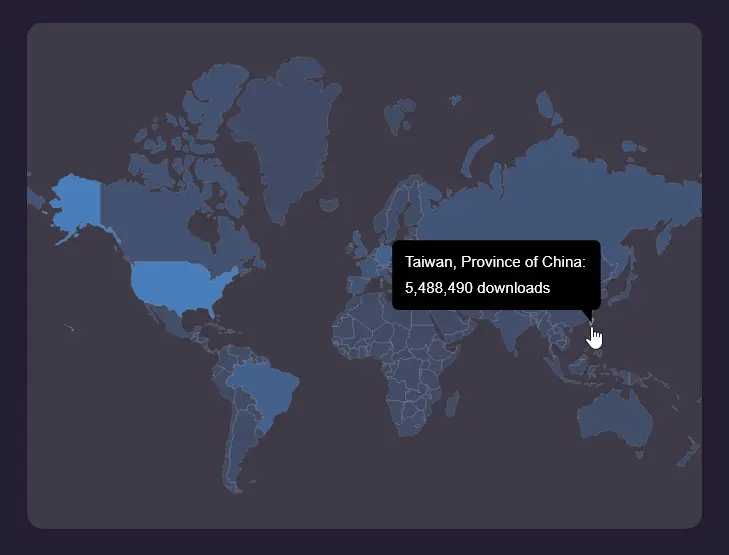- cross-posted to:
- linux@lemmy.ml
FOSS keeps winning it’s Insane!
deleted by creator
Brazil has so many downloads
As a professor I have to say… the site admin skipped the class that taught them to include always the color bar.
I’d prefer to see downloads per country per capita.
Right? “Oh look, country with huge population has more downloads than country with small population!”
What’s the issue? I installed mint because I know fuckall about Linux, and tbh it’s a dice toss if I have used the Flatpak option not knowing what the actual difference between them are
I’ll add upon what others have said here, for me the main downside is the size they take on disk since they don’t really share dependencies (they do but not as efficiently as native or nix packages) so they take a lot of room and take a while to update. Otherwise they’re amazing IMO and you should use them! :)
Flatpak “containerizes” the program, which makes it more secure and less able to accidentally mess up other programs. Fuck if I know how it works.
Also you don’t have to type in your password every time you want to update the program, so that’s nice.
Thing is, if your flatpak software needs something not in its container, it gets a little complicated, because first you have to realise what exactly the problem is and secondly you have to use something like flatseal to give it access to wathever it needs to work (no real help there)
So this was what took me back to pacman (or better said yay)
Honestly, you don’t have to worry about what others say, you should use what works best for you. Personally I find them to be nice and comfortable to use, myself 😅
lol

You see I play both sides, that way I always come out on top
North Korea: 316 downloads
Interesting…
In all seriousness, in both my home country and the country I live in, the number of downloads surpasses the population numbers which is kinda insane.
I think they count every download of every package, every version, every time. It’s not the number of unique users or even packages.
If you install 3 apps you might need to download 3 versions of graphics driver, 3 versions of desktop environment libraries and so on, It won’t count as one user installing 3 apps, it will show up as 10 -20 downloads. And that’s just the initial install, every time you update them it counts another 10-20.
It could be simple download requests, rather than MAC or IP address downloads.
It is per download not per person.
Crazy, how our “free world” is centralized
Touche. Centralized and un-mirrorable.
Unmirrorable? The whole thing, including the configs are open source?
Unmirrorable
Yes, unlike apt repositories, it wasn’t designed to be mirrored around, run isolated servers etc.
Flatpak was designed to be decentralised, Flathub is just the main repository offering flatpaks and yes, probably 99% of all Flatpak applications are downloaded via the main repo but it is technically possible to just launch your own if you are unhappy with the main repo. The Flatpak team literally has this info page for hosting a repository
I for example, am taking AAGL from their own flatpak repo because they are not offering their launcher via the main one (even tho they also tell you to link the main repo - I guess for dependency reasons - but theoretically you could open your own repo and throw all dependency related packages in there or am I getting something wrong here)
I agree with everything you said, however there are a few details.
it is technically possible to just launch your own [repo]
The ability to create repositories ≠ from mirror existing ones.
Unlike apt repositories Flatpak ones aren’t simply a directory tree with a bunch of files that can get mirrored using rysnc or other efficient means, it’s a clusterfuck of HTTP-only requests that need to be backed by specific metadata and there aren’t tools to manage those.
flatpak create-usbmay be promising but the name says its all - the priority wasn’t to create a way to mirror repositories but a quick and dirty hack for some situation.theoretically you could open your own repo and throw all dependency related packages in there or am I getting something wrong here
Theoretically yes, in practice things are bit more nuanced. That tools only considers your current architecture, it’s a pain to get dependencies in an automated way and most of the time you’ll end up with broken archives. You’ll also need to hack things a lot.
Ah, thx for the explanation :)
Flathub is not the entirety of Free World, just a little small slice of the pie. You can say Flathub is quite centralized. But our Free World have so much more. Every country will have a certain focus of what is freely available. It’s an optional server and package format. You are free to install it or use another free package. Nothing crazy here.
Still no proper way to mirror the thing and have it working offline / on internal networks. Great job self-hosters and sovereign citizens ;)
You absolutely can as Flatpak can run completely local. You can create a custom repo if you want.
Did you ever try doing that with public packages?
You can but I wouldn’t
Offline/internal network installs can be handled with
flatpak create-usb- https://docs.flatpak.org/en/latest/usb-drives.htmlOne can distribute flatpaks along with their dependencies on USB drives (or network shares, etc.) which is especially helpful in situations where Internet access is limited or non-existent.
Cache/mirroring would be great for those who need it.
Thinking about it, I wonder if there’s enough “core features” with ‘create-usb’ that its just matter of scripting something together to intercept requests, auto-create-usb what’s being requested and then serve the package locally?
The issue is that… there aren’t enough “core features”. It doesn’t even handle different architectures and their dependencies correctly. It wasn’t made to be mirrored, nor decentralized.
Apt for instance was designed in a much better way, it becomes trivial to mirror the entire thing or parts and for the end tool it doesn’t even matter if the source is a server on the internet, a local machine, a flash drive or a local folder, all work the same.
Apt is a package manager. Flatpak is an app format that happens to have a package manager. It isn’t designed to manage a OS.
Flatpaks are not centralized, Flathub is. You can have your own repo.
Yeah sure, just try to mirror Flathub into your repo.
I don’t get it. Why would you store all of it? I mean, you can but… why?
Because…
- Universities might want to locally host a mirror in order to waste less bandwidth and provide faster downloads;
- Large companies usually like to host internal mirrors for the same reasons as above and also so they can audit and pick what packages will be available for their end users;
- Flathub is slow af for some people;
- Local country-specific mirrors are always faster;
- In some countries not everyone can access the official flathub;
- One might be dealing with airgapped networks and systems for sensitive work and you want to have ways for your end users to install flatpaks;
- Fastly, their CDN might go down at any point (like Cloudflare sometimes does) and you’ll end up with nothing;
- Flathub itself may be subject to a cyberattack and their service might get crippled for a days or weeks and you’ll have nothing as well;
For what’s worth Debian archive repositories are about 5 TB and people actively mirror then in universities, companies, cloud providers etc.
The question here isn’t “why would you” but rather “why would I be unable to do it”. Their actively gatekeeping their repository in a futile attempt to be the single and central point of flatpak distribution - much like what Apple does with the App Store.
You can but there would be little point. Fedora has its own repo for instance.
Funny how it isn’t popular in countries with population several times larger than the USA. I guess every outside of the US can see through the bullshit of corporate-hijacked open-source.
the bullshit of corporate-hijacked open-source.
???
I’ve written about this here already.
China blocked Flathub
average lemmy.ml mf
And your point being?
Could you elaborate?
Narrator: “But no, they could not elaborate.”
Please check this comment.
It could also he that those people aren’t using computers with Linux
With the largest group of people graduating with an engineering degree, you’re telling me they don’t use Linux? Just check the stats at NSF for the number of degrees awarded in S&E.
India alone has 14% in the desktop market share for Linux. China’s market share is not easy to tell, thanks to the firewall, but 90% of government computers use Kylin and other Chinese-developed distros.
Do you maybe mean snap?
Snaps are a default no, obviously. Most of the points by Flatkill still hold true to this day. Apart from that, I have my own set of disagreements which I’ll not be talking about - basically, stuff like reproducibility, storage space, inconsistent permissions, inconvenient configurations, outdated runtime - well, you get the point, so I’ll not be expanding on that.
My primary disillusionment towards Flatpak has to do with how people with shared backgrounds and vested corporate interests have taken over open-source - in this particular case, I am talking about Big Tech. It’s almost as if the space for a community-developed organization is hijacked by them - by them occupying core positions of the organization.
These organizations do not follow a horizontal approach to decision-making, they often come up with decisions without consulting folks that aren’t within their direct circle, and worst, when they’re held in a tight-spot, they can evade any criticism by appealing to authority - that they’re the maintainers/contributors, and they know what’s best for the project’s future.
The same is true about funding - it is always through members of the company that they’re indirectly funding these projects, that I can’t help but feel that the “community”, aka the outsiders never had the chance to be a part of the decision-making.
Flatpak may have it’s share of poor features that can be fixed - sand-boxing can be improved by using permissive containers that allow particular shell variables, installation will throw dialogue, informing the users beforehand about the permissions these apps will need, developers may be forced to use proper run-times, and perhaps, some of the runtime be eliminated to use system dependencies, thereby complying with storage compliance - I don’t know, but it could be fixed. But this invisible, unspoken flaw in the governance? No way.
You’re complaining about corporate fundings. Without them, a lot of open source tech would definitely not be as advanced as it is today. Since everything’s open source, anyone can just fork a project when some “malicious megacorp” “hijacks” the project. Funny how a similar case happened “the good way” recently with Redis/Valkey, but the other way around.
There’s always some doomers only seeing potential bad futures in awesome stuff, huh?
Oh sorry, I should’ve mentioned why I hate RedHat. Well, I used to like it. Like is an understatement, I used to love them. Because I was one of those college grads who wanted to take part in RedHat’s Tev-Aviv program for the open-source AI and software stuff. I was so thankful and enthusiastic about contributing to Linux. And even though I was not selected, I would embrace their products, and related OSS projects - I ditched Ubuntu, and stayed with Fedora for almost four years, before I had a change of heart last September.
How US Big Tech supports Israel’s AI-powered genocide and apartheid
IBM’s Role in the Holocaust – What the New Documents Reveal
Genocide profiteer IBM wins big on EU funding
A Marriage Made in Hell: An Introduction to Microsoft’s Complicity in Apartheid and Genocide
I didn’t want to go on a political rant, but here we are. The world ain’t single-dimensional, chief. It is the culmination of every factor that makes me hate Fedora, Flatpak, systemd - am I forgetting something else? I hope not. Not every opposition to corporate support of open-source is some unhinged boomer rant about the good ol’ days of X11 and POSIX-compliant shell - well, I’m a Gen-Z kid, to begin with. I couldn’t give a rat’s ass about the advancement of open-source, if the cost is supporting another corporation responsible for the Holocaust, Nakba and Apartheid. Those injustices and deaths were avoidable. As someone from a former colony, I can not, and will not tolerate enabler of these atrocities.
Well you do you. I don’t see the point in hating open source software made by them, you’re not paying them unlike with regular products and boycotting them.
Or maybe the two countries with a larger population than the United States have significantly lower per capita income and so fewer people own desktop/laptop computers. Most of the world probably has, at most, a smartphone.
If anything, Brazil seems like the outlier on the that map. You’d expect the U.S. to have the most computers. But Brazil and China are roughly similar in terms of income.
Wrong, India and China has the highest number of engineering grads. From NSF:
India awarded 2.5 million S&E first university degrees in 2020, followed by China (2.0 million) and then by the United States (900,000).
With a younger population that is more than ever, a need for laptop would be in the highest demands. In fact, if you check the desktop market share for Linux in India, it is the highest, at around 14%.
Great opportunity to inject malware to so many vulnerable peeps then
You could say that with any program distribution. At least flatpaks are containerised.
Nah. Most distro package managers verify their packages authenticity with cryptography since the early noughts
Oh wow, a lot of people use it in countries with a lot of people!
Except that the download numbers don’t correspond at all with the population numbers.
Only Brazil is there because it has a big population.
Pet peeve #209: implying DFW has a bigger furry scene than Austin. For some reason I doubt that.
looks at India and China
I’m not seeing it.
MVP
Lol, what a pointless map.
It’s impossible to tell at a glance which countries have more or less downloads, other than a couple of countries with a slightly lighter colour.Yeah, they could have applied a logarithm or something.
And included a legend, such as a colour bar
Also, no novelty - strong reject, no revision possible 🙂↔️
What do you mean?
Such a Rev2!


















